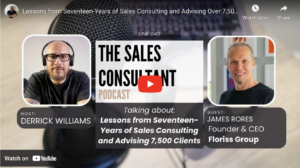One success pattern I’ve noticed for CEOs who established organizations that continually multiplied growth is the expectations they DID NOT place upon their Sales VP when they are hired or promoted into the role.
I’ll let the cat out of the bag early.
Sales leaders and CEOs that operate together on a truly SHARED sales FRAMEWORK are more likely to succeed. In short, when they have a shared vocabulary, process, systems, and metrics for accountability and success they can operate and grow as a unit.
When I say SHARED, I am implying that the CEO DID NOT expect the sales leader to come in and be solely responsible for implementing, communicating, and training to a sales framework while leading the sales strategy and sales results. CEOs that place this expectation on their sales leaders are highly likely to come away frustrated.
To dive into this, I’m going to borrow a model from our friends in systems engineering – a black vs. clear box approach. One you put inputs in, and only see the outputs on the other side. (black box). The other, you understand the inner workings of the model and assess as you test.
The Dreaded Black Box…
The storyline I’ve seen play out numerous occasions goes like this.
A sales leader is brought in to drive revenue for an organization. They are immediately asked to do the following:
- Analyze and set a strategy for growth in the current market
- Collaborate with marketing on critical messaging and tactics
- Set a process in place for hiring and retaining the best sales talent
- Outline the sales team structure that can execute on the strategy to drive results
- Define the sales process that will speed sales times and optimize deal flow
- Visit top tier customers to move deals forward, save relationships, and uncover the true value we bring to the table.
- Ensure their sales team is always trained to compete and win at the highest levels
- Manage board reporting and metrics for success
- Manage team reporting and metrics for success
- Work with all areas of the business to ensure that sales is a part of a winning culture
(Look at any of the major recruiting sites. This description may be underselling what a top sales leader is asked to do out of the gate.)
What happens in almost all cases is that the urgent and important outweigh the systematic and habitual. You find the immediate focus gets set on strategy, revenue shortfalls, team issues, and customers. Things like training, vocabulary, and a successful sales framework are relegated to the sidelines in the initial periods of the sales leader’s tenure, rather than being a shared focus of the leadership team. A shared vocabulary doesn’t get built early for the leadership unit or sales team.
The organization is out of balance.
When systematic and habitual sales frameworks are finally paid attention to, they are then often superficially conceived, built and communicated. Due to a broad range of to-dos, sales leaders often revert to frameworks that have worked in the past in OTHER companies, but are not vetted out and fully baked for the current role. Sales processes are left half-baked or misunderstood by leadership teams, sales teams, or both. PowerPoint presentations are given, but never fully bought into, implemented, and followed up on with coaching.
This is not due to bad intentions, or even poor work most of the time. Instead, it is due to having the expectations that are too heavily weighted on the urgent and important vs. systematic and habitual. It is a result of CEOs and leadership teams leaving the basic sales framework and vocabulary up to the VP alone, and never truly buying in to the need for a shared framework for growth.
What happens is the BLACK BOX in the organization – or the dreaded “sales silo.” Because a unified framework is not adopted, agreed upon, reinforced and shared from the highest levels, information goes in multiple spots on the sales team. It is stored in the CRM, in the minds of the Sales VP, in the minds of the sales reps, and maybe in some reports. It gets siloed in the sales organization at best, and at worst it is siloed in the minds of those individuals. Ultimately, it never really helps the organization.
Only upon the organization’s death, or the VP’s eventual firing, do the details ever come out. I’ve seen in a lot of cases that many of those details are good, but there was never enough attention paid to the FRAMEWORK that connected the sales organization to truly enable growth. Good decisions were never made from the information because it was never truly understood.
…vs. the Clear Box approach
Leadership teams I’ve seen prepare well for growth focus on ensuring there is a growth framework, a.k.a. a sales framework, in place that is mutually understood and operated upon apart from the sales leader themselves. The sales leader is responsible for operating the team upon the framework, but not solely responsible for implementing it.
It only makes sense, doesn’t it?
Shouldn’t the CEO know and understand the steps, systems, vocabulary, and metrics on what goes into forecasting business? Isn’t this important for them to be able to correctly lead the organization? Doesn’t the leader of the development team need to know how their software product is being sold, and how new feature requests are being handled in the market? Wouldn’t they have more faith their sales team is doing right by them? Shouldn’t the whole leadership team be able to understand and describe specifics of the sales and growth pipeline with confidence?
This leads to a clear box – known inputs, known components working together, and predictable outputs. When a sales leader is operating within, leading, and improving on a unified FRAMEWORK that has been agreed upon, understood, and adopted by the whole leadership team, the risk of the BLACK BOX goes down exponentially.
A shared playbook can be run. A team can call audibles if they need to with information that is gathered, because they know the accuracy and relevancy of the information. Growth can happen because true learning through change can be achieved, and barriers blocking change can be removed.
I’ve found the best teams work hard at developing frameworks TOGETHER. They…
- map the sales process from start to end
- work to identify the best possible buying experience they can provide
- involve all areas of their organization
- systematize it through technology
- codify it and educate on it …as an organizational habit
- continually strive to make it better, and modify their systems to update it
- base metrics for success off of it.
The killer expectation – a choice of two paths
Leaders in growth companies can choose to place the expectations of doing everything on a sales leader. The stats show that it won’t work out well. Only 6% of organizations can effectively self-diagnose their own sales problems, 58% of B2B pipelines are fluff that end in no decision, and most companies that make it to growth stage fail.
The first choice is often made. Companies hire a sales leader and give them that killer expectation. They say, “Just come in and make it happen!”
Have you done that?
Has that been your path?
I’ve seen the likelihood of success there isn’t great. There only a few sales leaders that can execute all the tasks above, and even fewer that can execute them all well.
The more effective choice is that CEOs and executives can invest in developing their sales framework alongside their top sales leaders, rather than putting it all on them.
These companies have a greater opportunity for success! They open the door for consistent growth by investing in the intellectual property they need for continual sales results.










